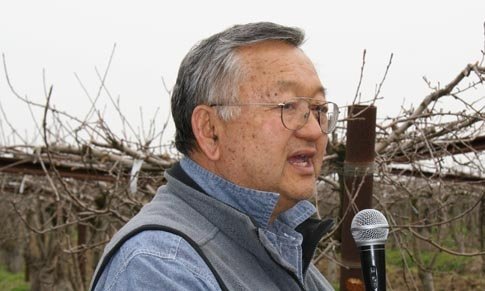
Tadashi “Tad” Kozuki has always tried to be at the forefront of new tree fruit varieties. He was an early grower of Asian pears, white-fleshed peaches, and Fuji apples, and now grows organic apples in California’s San Joaquin Valley as a way to be different.
Kozuki, a third-generation family farmer, returned to the family orchard in the 1960s to join with his brother in farming with his parents. Today, fourth and fifth generations of Kozukis are working in the orchards, producing a wide range of tree fruits on 800 acres in Parlier. His grandparents and parents began growing fruit in the 1920s, only to be relocated during World War II because of their Japanese ancestry. But they were more fortunate than many sent to internment camps. One of their employees moved into their home and took care of the orchards until they returned, saving everything as it was, Kozuki said.
The Kozukis were some of the earliest to plant Fujis in California, and they tried their best to make them color. “Fujis looked good at the start, had a great taste, but with California’s heat, we can’t get color,” he said. “First, we found out we couldn’t get them to color, then we found out Taiwan didn’t want green Fujis.”
The Fujis were planted to the horizontal Lincoln trellis system developed in New Zealand. After disappointment with the Fuji coloring, they tried covering the Fujis with shade cloth material and even bagging individual fruit.
At one time, they had 130 acres devoted to Fuji and other apple varieties. Only 30 acres now remain—the Fujis were grafted to organic Granny Smiths. However, they are planting an additional block of Buckeye Galas on M.9 in a Tatura trellis system.
“We are about the last apple grower left in Fresno County,” he said.
Kozuki said that he wouldn’t use the Lincoln trellis system again if he had known how the Fuji deal would turn out. “I could have saved a lot in trellis material,” he said, adding that production has not been very good, averaging around 500 boxes per acre. The tree strength seems to go over the trunk to the middle of the trellis, and he thinks that he probably gets smaller apples than he would get from a freestanding tree. However, sunburn is not an issue as it is in freestanding trees.
Converting to organic production was difficult, with codling moth the biggest challenge. But now that they have it figured out, the Galas will be planted as organic instead of transitioning from conventional to organic. All of their organic apples are shipped to Santa Cruz and packed and marketed by CF Fresh, an organic marketer headquartered in Sedro Woolley, Washington.
The Kozuki brothers have carved a niche in the specialty crops of organic Asian pears, growing 150 acres of Hosui and Shinko varieties. One of the few Asian pear growers in California, they pack the delicate fruit themselves, clipping the stems during harvest and putting foam socks around some while using a tray pack for others. They’ve learned that a tight pad fitting over the fruit inside the box is important in protecting the fragile fruit.
Asian pears require flower thinning by hand to achieve size. They also prune one-year-old wood to help the tree spur up on the backside of scaffolds.
Puffers that automatically dispense codling moth pheromone at night are used to control codling moth. One puffer per acre is used, with pheromone strips used on the outside edges. Fireblight can also be a problem in Asian pears.
Growing for the organic Asian pear market is necessary to make it worthwhile, Kozuki said. “We couldn’t do it if we were growing conventional,” he said, noting that conventional Asian pears sell for $18 per box compared to $30 for an organic box. Yields are around 800 to 1,000 flats per acre. A flat weighs 10 pounds.
“You can’t just grow peaches and nectarines anymore,” he said. “You have to diversify to survive.”
When the white-fleshed peaches and nectarines and white-fleshed donut peaches were initially released, the Kozukis planted some of the first varieties and did quite well. “But you can’t keep a secret in the industry,” he said, adding that the white-fleshed fruit are not a specialty crop anymore.
He said that 2007 was a particularly tough year for stone fruit growers in California because the crop was so big. Peaches, plums, and nectarines topped 55 million boxes, not counting an unofficial estimate of 5 million boxes of Pluots and Plumcots. “Whenever we pass the 50-million mark, marketing gets tough. We can’t store stone fruit like apples.”

Leave A Comment